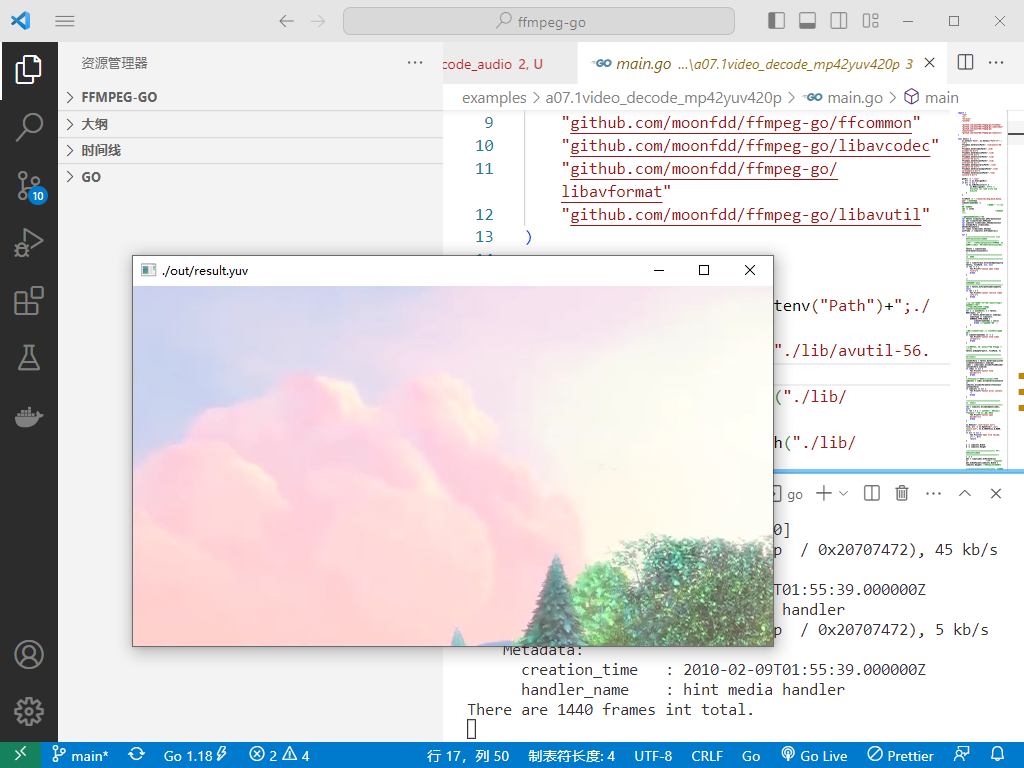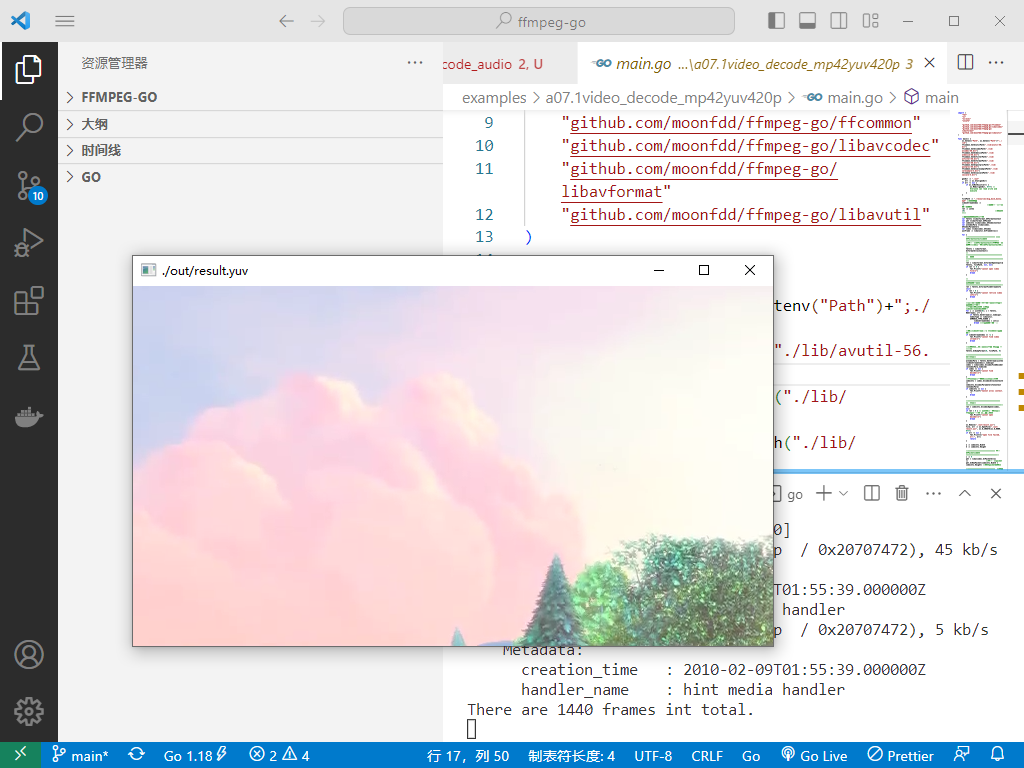1
2023-02-23:请用 go 语言调用 ffmpeg,解码 mp4 文件并保存为 YUV420P 格式文件。
作者:福大大架构师每日一题
- 2023-02-23 北京
本文字数:2941 字
阅读完需:约 10 分钟

2023-02-23:请用 go 语言调用 ffmpeg,解码 mp4 文件并保存为 YUV420P 格式文件。
答案 2023-02-23:
使用 github.com/moonfdd/ffmpeg-go 库。
解码后就是 yuv420p,直接保存 frame 的 yuv 分量即可。
命令如下:
go run ./examples/a07.1video_decode_mp42yuv420p/main.go
复制代码
参考了07:解码视频并保存为YUV格式文件,代码用 golang 编写。代码如下:
package main
import ( "fmt" "os" "os/exec" "unsafe"
"github.com/moonfdd/ffmpeg-go/ffcommon" "github.com/moonfdd/ffmpeg-go/libavcodec" "github.com/moonfdd/ffmpeg-go/libavformat" "github.com/moonfdd/ffmpeg-go/libavutil")
func main() { os.Setenv("Path", os.Getenv("Path")+";./lib") ffcommon.SetAvutilPath("./lib/avutil-56.dll") ffcommon.SetAvcodecPath("./lib/avcodec-58.dll") ffcommon.SetAvdevicePath("./lib/avdevice-56.dll") ffcommon.SetAvfilterPath("./lib/avfilter-56.dll") ffcommon.SetAvformatPath("./lib/avformat-58.dll") ffcommon.SetAvpostprocPath("./lib/postproc-55.dll") ffcommon.SetAvswresamplePath("./lib/swresample-3.dll") ffcommon.SetAvswscalePath("./lib/swscale-5.dll")
genDir := "./out" _, err := os.Stat(genDir) if err != nil { if os.IsNotExist(err) { os.Mkdir(genDir, 0777) // Everyone can read write and execute } }
filePath := "./resources/big_buck_bunny.mp4" //文件地址 videoStreamIndex := -1 //视频流所在流序列中的索引 ret := int32(0) //默认返回值
//需要的变量名并初始化 var fmtCtx *libavformat.AVFormatContext var pkt *libavformat.AVPacket var codecCtx *libavcodec.AVCodecContext var avCodecPara *libavcodec.AVCodecParameters var codec *libavcodec.AVCodec yuvFrame := libavutil.AvFrameAlloc()
for { //=========================== 创建AVFormatContext结构体 ===============================// //分配一个AVFormatContext,FFMPEG所有的操作都要通过这个AVFormatContext来进行 fmtCtx = libavformat.AvformatAllocContext() //==================================== 打开文件 ======================================// ret = libavformat.AvformatOpenInput(&fmtCtx, filePath, nil, nil) if ret != 0 { fmt.Printf("cannot open video file\n") break }
//=================================== 获取视频流信息 ===================================// ret = fmtCtx.AvformatFindStreamInfo(nil) if ret < 0 { fmt.Printf("cannot retrive video info\n") break }
//循环查找视频中包含的流信息,直到找到视频类型的流 //便将其记录下来 保存到videoStreamIndex变量中 for i := uint32(0); i < fmtCtx.NbStreams; i++ { if fmtCtx.GetStream(i).Codecpar.CodecType == libavutil.AVMEDIA_TYPE_VIDEO { videoStreamIndex = int(i) break //找到视频流就退出 } }
//如果videoStream为-1 说明没有找到视频流 if videoStreamIndex == -1 { fmt.Printf("cannot find video stream\n") break }
//打印输入和输出信息:长度 比特率 流格式等 fmtCtx.AvDumpFormat(0, filePath, 0)
//================================= 查找解码器 ===================================// avCodecPara = fmtCtx.GetStream(uint32(videoStreamIndex)).Codecpar codec = libavcodec.AvcodecFindDecoder(avCodecPara.CodecId) if codec == nil { fmt.Printf("cannot find decoder\n") break } //根据解码器参数来创建解码器内容 codecCtx = codec.AvcodecAllocContext3() codecCtx.AvcodecParametersToContext(avCodecPara) if codecCtx == nil { fmt.Printf("Cannot alloc context.") break }
//================================ 打开解码器 ===================================// ret = codecCtx.AvcodecOpen2(codec, nil) if ret < 0 { // 具体采用什么解码器ffmpeg经过封装 我们无须知道 fmt.Printf("cannot open decoder\n") break }
os.Remove("./out/result.yuv") file, err := os.OpenFile("./out/result.yuv", os.O_CREATE|os.O_RDWR, 0777) if err != nil { fmt.Println("open file failed,err:", err) return }
w := codecCtx.Width h := codecCtx.Height
//=========================== 分配AVPacket结构体 ===============================// i := 0 pkt = libavcodec.AvPacketAlloc() //分配一个packet pkt.AvNewPacket(codecCtx.Width * codecCtx.Height) //调整packet的数据
//=========================== 读取视频信息 ===============================// for fmtCtx.AvReadFrame(pkt) >= 0 { //读取的是一帧视频 数据存入一个AVPacket的结构中 if pkt.StreamIndex == uint32(videoStreamIndex) { if codecCtx.AvcodecSendPacket(pkt) == 0 { for codecCtx.AvcodecReceiveFrame(yuvFrame) == 0 { i++ bytes := []byte{} //y ptr := uintptr(unsafe.Pointer(yuvFrame.Data[0])) for j := int32(0); j < w*h; j++ { bytes = append(bytes, *(*byte)(unsafe.Pointer(ptr))) ptr++ } //u ptr = uintptr(unsafe.Pointer(yuvFrame.Data[1])) for j := int32(0); j < w*h/4; j++ { bytes = append(bytes, *(*byte)(unsafe.Pointer(ptr))) ptr++ } //v ptr = uintptr(unsafe.Pointer(yuvFrame.Data[2])) for j := int32(0); j < w*h/4; j++ { bytes = append(bytes, *(*byte)(unsafe.Pointer(ptr))) ptr++ } //写文件 file.Write(bytes) } } } pkt.AvPacketUnref() //重置pkt的内容 } fmt.Printf("There are %d frames int total.\n", i) file.Close() break } // //===========================释放所有指针===============================// libavcodec.AvPacketFree(&pkt) codecCtx.AvcodecClose() libavformat.AvformatCloseInput(&fmtCtx) fmtCtx.AvformatFreeContext() libavutil.AvFrameFree(&yuvFrame)
_, err = exec.Command("./lib/ffplay.exe", "-pixel_format", "yuv420p", "-video_size", "640x360", "./out/result.yuv").Output() if err != nil { fmt.Println("play err = ", err) }}
复制代码

划线
评论
复制
发布于: 刚刚阅读数: 4
版权声明: 本文为 InfoQ 作者【福大大架构师每日一题】的原创文章。
原文链接:【http://xie.infoq.cn/article/99ea4fad3d863217e80304353】。
本文遵守【CC-BY 4.0】协议,转载请保留原文出处及本版权声明。
福大大架构师每日一题
关注
还未添加个人签名 2021-02-15 加入
还未添加个人简介











评论